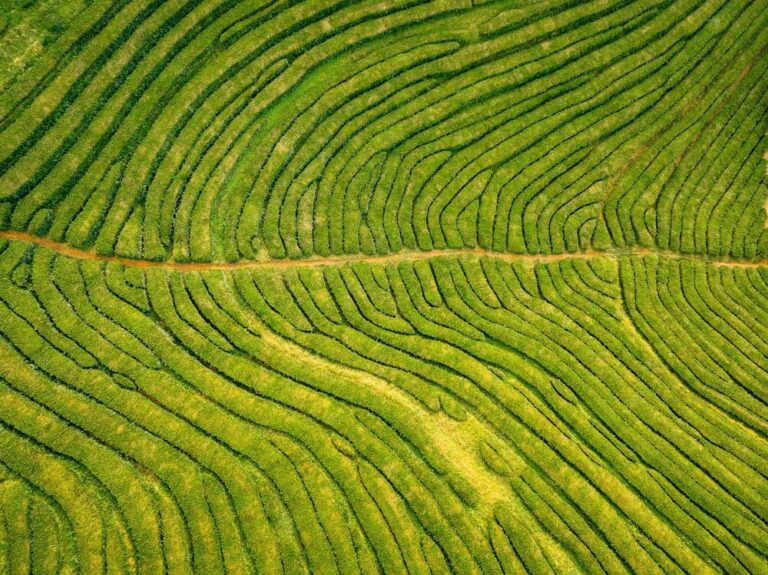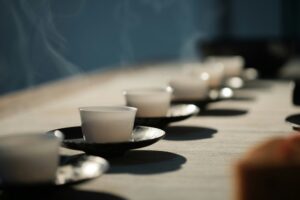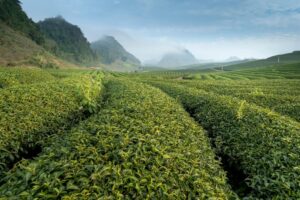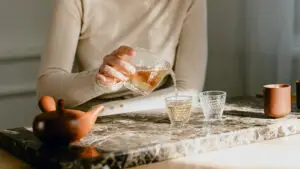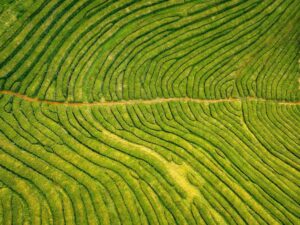Tea lovers often explore the rich world of Chinese teas. Oolong tea and pu erh tea are two favorites. They offer unique flavors and health benefits, making them popular.
Oolong tea is between green and black teas in oxidation levels. Its processing methods create a wide range of flavors. Pu erh tea, with its post-fermentation, has complex, earthy notes that grow over time.
Both teas have unique origins and histories. Oolong tea comes from China’s Fujian province, dating back to the Tang Dynasty. Pu erh tea is from Yunnan, China, known for its special post-fermentation process.
Let’s dive into the world of oolong tea vs pu erh tea. We’ll look at their processing, flavors, and health benefits. This comparison will help you understand these beloved Chinese teas better. It will also guide you in picking the perfect tea for you.
Understanding Traditional Chinese Teas
Chinese tea culture is ancient, spanning thousands of years. The camellia sinensis plant is the source of many teas. These include white, green, oolong, black, and pu-erh teas, each with its own flavor.

China leads the world in tea production. It’s famous for teas like Dragon Well green tea and Ti Kuan Yin oolong. In China, black teas are called “red teas,” and “black tea” means aged and fermented teas like pu-erh.
Tea caffeine levels differ. White teas have 10-15 mg per 8 oz cup. Black teas have 40-60 mg. Green teas have 30-35 mg. Oolong teas start with 30-50 mg in the first cup, then drop to 5-10 mg by the third.
| Tea Type | Caffeine Content (per 8 oz cup) | Notable Varieties |
|---|---|---|
| White | 10-15 mg | Jasmine Silver Needle, White Peony |
| Green | 30-35 mg | Chun Mee, Dragon Well, Gunpowder |
| Oolong | 30-50 mg (first cup) | Ti Kuan Yin, Milk Oolong, Ginseng Oolong |
| Black | 40-60 mg | China Keemun, Lapsang Souchong, Golden Yunnan |
| Pu-erh | Varies | Sheng (raw) Pu-erh, Shou (ripe) Pu-erh |
The Gongfu Cha ceremony highlights Chinese tea culture’s depth. It uses small yixing clay teapots for short infusions. This brings out the flavors of teas like oolong and pu-erh. Tea is the world’s second most popular drink, loved for its traditions and health benefits.
Oolong Tea vs Pu Erh Tea
Tea lovers often get excited about the wide range of Chinese teas. Oolong and Pu Erh are two teas that really stand out. They have unique qualities that make them special in the tea world.
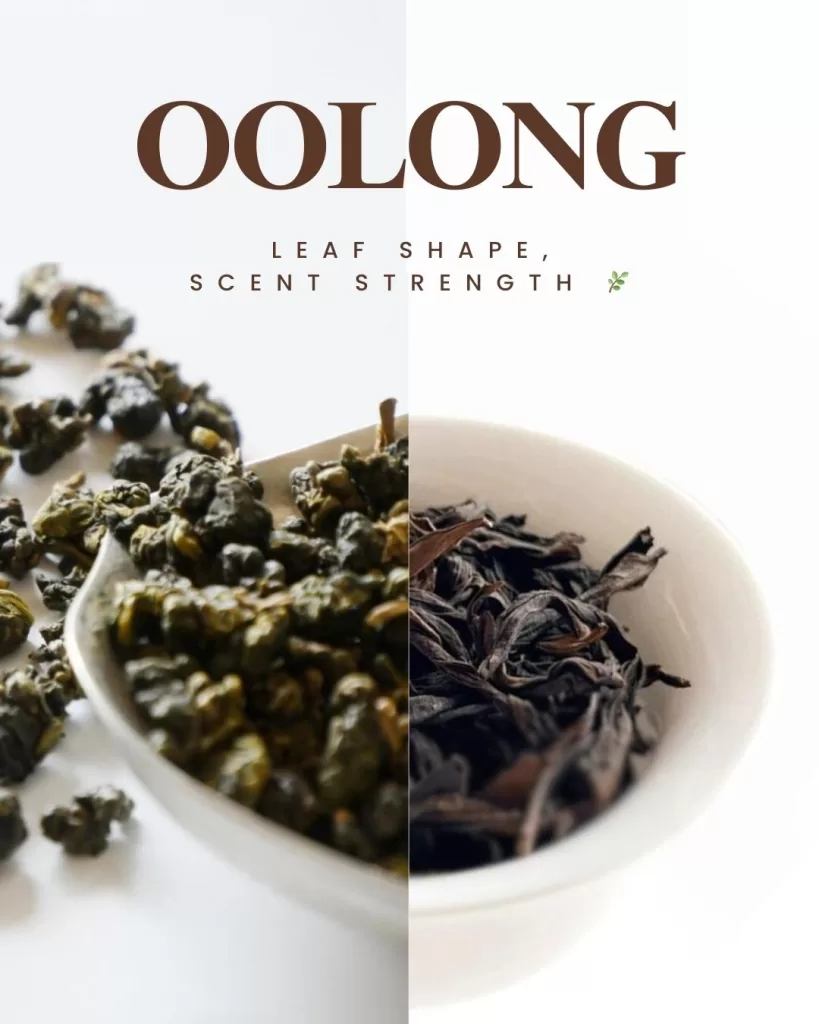
Oolong tea is somewhere between green and black tea in oxidation, from 10% to 80%. It has a wide range of flavors, from floral and light to rich with stone fruit notes. Making Oolong involves steps like withering, oxidation, and drying. Famous types include Tieguanyin, Da Hong Pao, and Milk Oolong.
Pu Erh, from Yunnan, China, is a fermented tea. It comes in raw (Sheng) and ripened (Shou) forms. Its aging process makes its flavor even more complex over time. The making of Pu Erh includes steps like plucking and fermentation.

To brew Oolong, use water between 85-95°C (185-205°F) for 3-5 minutes. Pu Erh needs even hotter water, 95-100°C (203-212°F), and steeps longer, especially for older teas. Both teas offer unique flavors and aromas, making them favorites among tea lovers.
| Characteristic | Oolong Tea | Pu Erh Tea |
|---|---|---|
| Origin | China and Taiwan | Yunnan, China |
| Oxidation Level | 10-80% | Fully oxidized and fermented |
| Flavor Profile | Floral to full-bodied | Earthy and complex |
| Caffeine Content | 30-50 mg per cup | Similar to black tea |
| Brewing Temperature | 85-95°C (185-205°F) | 95-100°C (203-212°F) |
Origins and Historical Background
Tea history is long, over 5,000 years, with China at its heart. Chinese tea origins go back to Emperor Shennong, who introduced tea in 2737 BC. The habit of drinking tea started in the Shang Dynasty (1766-1050 BC), beginning a rich tradition.
Pu Erh tea, a dark tea from Yunnan, has roots in the Han Dynasty. It became famous as a tribute tea in the Tang Dynasty. The Old Tea Road between Yunnan and Tibet helped spread Pu Erh. Tea leaves for Pu Erh come from wild Camellia Sinensis trees in Yunnan’s mountains.
Oolong tea came later, in the Ming Dynasty (1368-1644). Tea makers tried different fermentation levels, creating a unique category. Oolong’s oxidation ranges from 8% to 70%, leading to varied flavors.
The tea trade greatly influenced global commerce. Portuguese missionaries brought Chinese tea to Europe 400 years ago, sparking demand. This led the British to start tea production in India in the 17th century to challenge China’s monopoly.
| Tea Type | Origin Period | Key Characteristics |
|---|---|---|
| Pu Erh | Han Dynasty (202 BC – 220 AD) | Aged, dark tea from Yunnan |
| Oolong | Ming Dynasty (1368 – 1644) | Semi-oxidized, between green and black tea |
Processing Methods and Production
Tea processing is key to oolong and pu erh teas’ unique tastes. Oolong tea gets partially oxidized, while pu erh tea ferments. These steps shape the teas’ flavors and aging potential.
Oolong tea’s journey starts with plucking. The leaves then dry to lose moisture. Next, they’re shaken to bruise the edges, starting oxidation. This process can vary from 8% to 80%, creating a wide range of flavors.
Pu erh tea’s production is different. After plucking and drying, the leaves are fixed to stop oxidation. They’re then rolled and dried. The fermentation stage is unique, with Sheng pu erh aging naturally and Shou pu erh undergoing a controlled process.
| Processing Step | Oolong Tea | Pu Erh Tea |
|---|---|---|
| Withering | Yes | Yes |
| Oxidation | Partial (8-80%) | Minimal |
| Fermentation | No | Yes (post-production) |
| Aging Potential | Limited | High |
Oolong and pu erh teas have unique flavors and aromas thanks to their processing. Oolong’s flavors vary with oxidation levels. Pu erh’s complex tastes come from fermentation and aging.
Distinctive Flavor Profiles
Oolong and Pu Erh teas have unique flavors that excite tea lovers. Oolong tea tastes range from sweet and fruity to woody and roasted. Lightly oxidized oolongs have floral and fresh notes, while heavily oxidized ones offer full-bodied flavors with stone fruit and honey hints.
Pu Erh tea is known for its earthy taste. Raw Pu Erh starts astringent but gets milder with time. Ripe Pu Erh is smoother, with rich tastes of wood and dark chocolate. The aging process changes Pu Erh’s flavor a lot.
Tea aroma is key to the experience. Oolong teas often smell floral or fruity, while Pu Erh teas have earthy and sometimes musty scents. These unique aromas make each tea a special journey for those who love tea.
| Tea Type | Flavor Profile | Aroma |
|---|---|---|
| Light Oolong | Floral, fresh, sweet | Fragrant, light |
| Dark Oolong | Full-bodied, fruity, honey | Rich, roasted |
| Raw Pu Erh | Initially astringent, mellows with age | Earthy, complex |
| Ripe Pu Erh | Smooth, woody, dark chocolate | Deep, musty |
Brewing Techniques and Temperature
Learning how to brew tea is essential for enjoying Oolong and Pu-erh teas. The right water temperature is key to getting the best flavor. For Oolong tea, use water between 195°F and 205°F (90°C to 96°C). This temperature helps the leaves unfurl and release their flavors without bitterness.
Pu-erh tea, however, needs hotter water. Aim for 212°F (100°C) to bring out its earthy flavors. Both teas usually steep for 3 to 5 minutes. But, the time can change based on your taste and the tea’s type.
| Tea Type | Water Temperature | Steeping Time | Leaf to Water Ratio |
|---|---|---|---|
| Oolong | 195°F – 205°F (90°C – 96°C) | 3-5 minutes | 1-2 tsp per 8 oz |
| Pu-erh | 212°F (100°C) | 3-5 minutes | 1 tsp per 8 oz |
Both Oolong and Pu-erh teas can be steeped multiple times. Each time, you’ll discover new flavors. For Pu-erh, a quick rinse before the first steep can enhance the taste.
Health Benefits and Properties
Oolong and pu-erh teas have many health benefits. Oolong tea helps with weight management and blood sugar control. It’s full of antioxidants like theaflavins and catechins. These fight free radicals and may lower the risk of chronic diseases.
Pu-erh tea, grown only in China’s Yunnan province, has special properties. Its fermentation process aids digestion, lowers cholesterol, and boosts the immune system. Studies show it can lower bad cholesterol (LDL) and increase good cholesterol (HDL). It also has GABA and lovastatin, which are good for health.
Both teas help with weight management. Pu-erh tea improves digestion and reduces fat production, helping with weight loss. The polyphenols in these teas may also strengthen bones and fight cancer cells. Drinking these antioxidant-rich teas regularly can prevent common illnesses like colds and flu.
| Health Benefit | Oolong Tea | Pu-erh Tea |
|---|---|---|
| Weight Management | Supports metabolism | Improves digestion, suppresses fat synthesis |
| Heart Health | May reduce cardiovascular risk | Lowers LDL, increases HDL cholesterol |
| Antioxidant Content | High in theaflavins and catechins | Rich in polyphenols |
| Stress Reduction | Contains L-theanine | High in GABA and theanine |
Caffeine Content and Energy Impact
Tea lovers look for the right mix of caffeine and energy. Oolong and Pu Erh teas offer special profiles. Oolong has 50-75 mg of caffeine per 8 oz cup, and Pu Erh has 30-70 mg. This is less than coffee’s 95-200 mg.
Caffeine in tea is different from coffee. It’s released slowly because of L-theanine, an amino acid that helps you relax. This mix gives a smooth, lasting energy boost without coffee’s jitters.
Many things affect tea’s caffeine level. The type of tea, where it’s grown, and how it’s made all matter. For example, the Camelia Sinensis var. Sinensis variety has the most caffeine at 2.8% of dry leaf weight. Seasonal changes also impact caffeine levels, with some teas possibly having more in spring or summer.
| Tea Type | Caffeine Content (per 8 oz) |
|---|---|
| Black Tea | 60-90 mg |
| Oolong Tea | 50-75 mg |
| Pu Erh Tea | 30-70 mg |
| Green Tea | 30-50 mg |
| White Tea | 15-30 mg |
Storage and Aging Characteristics
Tea storage is key to keeping oolong and pu erh teas fresh. Oolong tea needs containers that are airtight, away from light, heat, and moisture. Unlike pu erh, oolong doesn’t get better with age.
Pu erh tea, especially the raw kind, loves to age well. To keep pu erh tea fresh, store it in cool, dry spots. Some pu erh teas age for decades, gaining rich flavors and value.
Tea lovers often prefer pu erh for its aging process. Oolong tea, though, can reach its best taste around 15 years. Storing oolong tea is easy, using simple tins without special tools.
The aging of pu erh is complex, involving fermentation. Raw pu erh ages differently because of its processing. The compression also plays a role, as inner leaves age differently from outer ones.
| Tea Type | Aging Potential | Storage Method |
|---|---|---|
| Oolong | Limited | Airtight containers |
| Raw Pu Erh | High | Cool, dry place |
| Ripe Pu Erh | Moderate | Cool, dry place |
When aging pu erh, look for bitterness as a sign of good aging. Quality, picking standards, and processing all impact aging. Pick a tea that’s affordable and suits your taste for a great aging journey.
Quality Assessment and Selection
Tea grading is key in judging oolong and pu-erh tea quality. For oolong, experts look at leaf appearance, aroma, and taste. High-quality oolongs have whole leaves and rich flavors.
Pu-erh quality depends on age, where it comes from, and how it’s made.
Oolong tea quality is shaped by how it’s processed. Studies found 18 terpenoid volatiles, 11 amino-acid-derived volatiles, and 15 fatty-acid-derived volatiles that make oolong unique. For pu-erh, how it’s stored greatly affects its quality, especially for older teas.
When picking teas, check the aroma, look at leaf quality, and learn about the producer or region. For pu-erh, remember that Yunnan has four main areas: Xishuang Banna, Lin Cang, Pu-erh, and Chang Ning. Each area gives pu-erh its own special taste.
| Tea Type | Key Quality Factors | Selection Tips |
|---|---|---|
| Oolong | Leaf appearance, aroma complexity, taste profile | Look for whole leaves, fresh odor, balanced flavor |
| Pu-erh | Age, origin, processing method, storage conditions | Consider vintage, check compression, assess aroma |
Conclusion
Oolong and Pu-erh teas are special in the world of traditional Chinese teas. This summary shows their unique traits. It makes choosing between them an exciting adventure for tea lovers.
Oolong tea has flavors that vary, thanks to its oxidation levels. It has more caffeine than green tea but less than black tea. It also has good stuff like flavonols and catechins. Oolong tea comes from China and Taiwan and is important in Chinese festivals.
Pu-erh tea is made from an ancient tea plant. It has a rich flavor that gets better with age. It’s known for its special aging process, lasting up to fifty years. Pu-erh tea is also used in traditional Chinese medicine for its health benefits.
Both teas offer unique tastes and health perks. Your choice between oolong and pu-erh depends on what you like and what you want to get from it. Whether you prefer oolong’s varied flavors or pu-erh’s aged taste, both offer a cultural experience and health benefits.
FAQ
What are the main differences between Oolong and Pu Erh tea?
Oolong tea is partially oxidized, with levels ranging from 8% to 80%. Pu Erh tea, on the other hand, undergoes post-fermentation. Oolong tea can taste from light and floral to dark and full-bodied. Pu Erh tea is known for its deep, earthy flavor.
Oolong tea comes from China and Taiwan. Pu Erh tea is specifically from Yunnan, China.
How do the health benefits of Oolong and Pu Erh tea compare?
Both teas offer many health benefits. Oolong tea helps with weight management, heart health, and blood sugar control. It’s packed with antioxidants and other beneficial compounds.
Pu Erh tea is great for digestion, cholesterol reduction, and boosting the immune system. It has unique compounds due to fermentation. Both teas can improve metabolism, skin health, and reduce stress.
What are the recommended brewing techniques for Oolong and Pu Erh tea?
For Oolong tea, use water between 185°F and 205°F. Use 1-2 teaspoons of leaves per 8 ounces, steep for 3-5 minutes. For Pu Erh tea, use boiling water and steep for 3-5 minutes after a brief rinse.
Both teas can be steeped multiple times. Each steep reveals new flavors.
How do the caffeine levels in Oolong and Pu Erh tea compare to coffee?
Oolong and Pu Erh teas have 30-50 milligrams of caffeine per 8 oz cup. This is less than coffee. They offer a milder, sustained energy boost.
The caffeine in tea is released slowly. This is thanks to L-theanine, which avoids the jitters found in coffee.
Can Oolong and Pu Erh tea be aged, and how does it affect their flavor?
Oolong tea doesn’t improve with long-term aging. It should be stored in airtight containers away from light, heat, and moisture. Pu Erh tea, especially raw (Sheng) Pu Erh, can age for years, developing complex flavors.
Proper storage in a cool, dry place is key for Pu Erh aging. Some Pu Erh teas are aged for decades, becoming smoother and more nuanced.
What are the key varieties of Oolong and Pu Erh tea?
Key Oolong varieties include Tieguanyin, Da Hong Pao, and Milk Oolong. Pu Erh tea has two main types: Raw (Sheng) and Ripe (Shou). There are many varieties based on region, age, and processing methods.
How do I assess the quality of Oolong and Pu Erh tea?
Quality Oolong tea has whole, unbroken leaves and a complex flavor. Pu Erh tea quality depends on age, origin, and processing. Aged Pu Erh’s storage conditions are crucial.
When choosing tea, look at aroma, leaf quality, and the producer’s reputation.
What is the historical significance of Oolong and Pu Erh tea in Chinese culture?
Both teas have deep roots in Chinese culture and trade. Pu Erh tea started in the Han Dynasty (202 BC – 220 AD) and became a tribute tea in the Tang Dynasty. Oolong tea’s history began in the Ming Dynasty (1368 – 1644) with experiments in fermentation levels.
These teas are central to Chinese tea ceremonies, social customs, and international trade.
